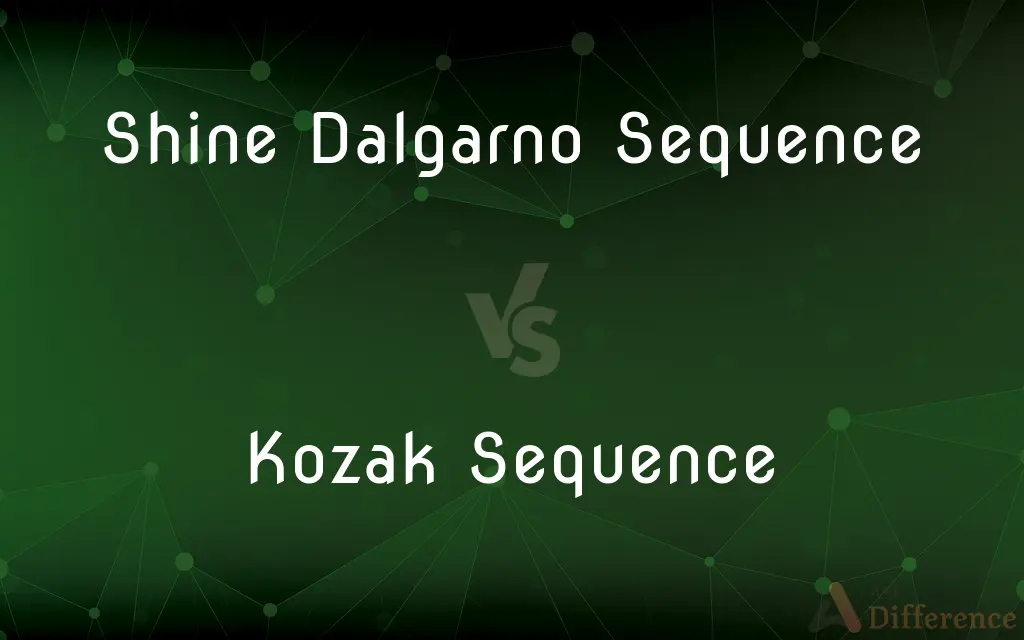Shine Dalgarno Sequence vs. Kozak Sequence — What's the Difference?
By Tayyaba Rehman & Urooj Arif — Published on February 16, 2024
The Shine-Dalgarno sequence is a ribosomal binding site in prokaryotic mRNA, while the Kozak sequence enhances translation initiation in eukaryotic mRNA.

Difference Between Shine Dalgarno Sequence and Kozak Sequence
Table of Contents
ADVERTISEMENT
Key Differences
The Shine-Dalgarno sequence and the Kozak sequence are both critical for the initiation of protein synthesis, but they operate in different organisms and contexts. The Shine-Dalgarno sequence is found in the mRNA of prokaryotes like bacteria and is situated a few nucleotides upstream of the start codon. It helps the ribosome align with the mRNA to initiate translation. In contrast, the Kozak sequence is present in eukaryotic organisms, including humans, and surrounds the start codon. This sequence is crucial for the ribosome to correctly identify the start codon and begin protein synthesis.
While the Shine-Dalgarno sequence aligns the ribosome with the mRNA by binding to a complementary sequence on the small ribosomal subunit, the Kozak sequence does not directly bind to the ribosome. Instead, the Kozak sequence enhances the recognition of the start codon AUG by the ribosomal machinery in eukaryotes, making the initiation of translation more efficient. The presence of specific nucleotides within the Kozak sequence, particularly surrounding the AUG start codon, plays a significant role in the efficiency of translation initiation.
The Shine-Dalgarno sequence's effectiveness lies in its ability to facilitate direct interaction between the mRNA and the ribosome, which is essential for protein synthesis in prokaryotes. This mechanism is simpler compared to the eukaryotic process, which involves more complex machinery and regulatory elements, including the Kozak sequence. The Kozak sequence's role reflects the complexity of eukaryotic translation initiation, involving multiple initiation factors and a cap structure at the mRNA's 5' end.
Despite their differences, both the Shine-Dalgarno and Kozak sequences are vital for life, enabling cells to produce proteins accurately. The Shine-Dalgarno sequence's role in prokaryotes and the Kozak sequence's function in eukaryotes illustrate the evolutionary divergence in the mechanism of translation initiation. Understanding these sequences is crucial for genetic engineering and biotechnology, as they can influence the expression of engineered genes in different organisms.
In summary, the Shine-Dalgarno sequence and the Kozak sequence are essential elements that facilitate the initiation of translation in prokaryotic and eukaryotic organisms, respectively. Their differences in location, mechanism of action, and organismal context highlight the diversity of life's molecular machinery for protein synthesis.
ADVERTISEMENT
Comparison Chart
Organism
Prokaryotes
Eukaryotes
Location
Upstream of the start codon
Surrounds the start codon
Function
Aligns ribosome with mRNA
Enhances start codon recognition
Interaction
With 16S rRNA of the small ribosomal subunit
With ribosomal machinery, not direct binding
Sequence Conservation
Less conserved, varies among species
More conserved, especially near the start codon
Compare with Definitions
Shine Dalgarno Sequence
A prokaryotic mRNA sequence for ribosome binding.
The Shine-Dalgarno sequence ensures accurate translation initiation in bacteria.
Kozak Sequence
Surrounds the AUG start codon.
Mutations in the Kozak sequence can lead to reduced protein expression.
Shine Dalgarno Sequence
Facilitates alignment of mRNA with ribosomes.
Effective protein synthesis in prokaryotes relies on the Shine-Dalgarno sequence.
Kozak Sequence
Critical for start codon recognition.
The strength of the Kozak sequence influences gene expression levels.
Shine Dalgarno Sequence
Essential for prokaryotic translation.
The Shine-Dalgarno sequence is a key target for antibiotic action.
Kozak Sequence
Enhances initiation of translation in eukaryotes.
The Kozak sequence is crucial for efficient protein synthesis in cells.
Shine Dalgarno Sequence
Interacts with the small ribosomal subunit.
The 16S rRNA recognizes the Shine-Dalgarno sequence to begin translation.
Kozak Sequence
Involves complex initiation factors.
The Kozak sequence works with eukaryotic initiation factors to start translation.
Shine Dalgarno Sequence
Found upstream of the start codon.
Mutation in the Shine-Dalgarno sequence can disrupt protein production.
Kozak Sequence
Found in eukaryotic mRNAs.
Gene engineering often optimizes the Kozak sequence for higher protein output.
Common Curiosities
What is the Shine-Dalgarno sequence?
It's a ribosomal binding site in prokaryotic mRNA, essential for translation initiation.
Is the Shine-Dalgarno sequence present in all prokaryotes?
While common in bacteria, variations exist, and it's not present in all prokaryotic organisms.
What does the Kozak sequence do?
It enhances the recognition of the start codon in eukaryotic mRNA, facilitating translation initiation.
Where is the Shine-Dalgarno sequence located?
Just upstream of the start codon in prokaryotic mRNA.
Can mutations in the Shine-Dalgarno sequence affect gene expression?
Yes, mutations can disrupt ribosome binding and thus protein synthesis.
What makes the Kozak sequence important for eukaryotic cells?
Its role in ensuring efficient and accurate translation initiation.
Are there tools to analyze the Shine-Dalgarno sequence?
Yes, bioinformatics tools can predict ribosomal binding sites in prokaryotic mRNA.
How does the Kozak sequence affect protein synthesis?
It affects the efficiency and accuracy of initiation of translation in eukaryotes.
What role does the Kozak sequence play in genetic engineering?
Optimizing the Kozak sequence can enhance the expression of recombinant proteins in eukaryotes.
How is the Shine-Dalgarno sequence identified?
By its purine-rich sequence located a few nucleotides upstream of the start codon.
What happens if the Shine-Dalgarno sequence is mutated?
Translation initiation can be impaired, leading to reduced protein synthesis.
How does the Kozak sequence vary between species?
While the core elements are conserved, variations can exist that affect translational efficiency.
Does the Kozak sequence interact directly with the ribosome?
It facilitates ribosome binding indirectly by enhancing start codon recognition.
How does the Kozak sequence influence translation efficiency?
The presence of certain nucleotides around the AUG start codon in the sequence can greatly influence efficiency.
Can the Shine-Dalgarno and Kozak sequences be used to control gene expression?
Yes, manipulating these sequences is a strategy to regulate protein production in both prokaryotes and eukaryotes.
Share Your Discovery

Previous Comparison
Nondisjunction in Meiosis 1 vs. Nondisjunction in Meiosis 2
Next Comparison
Windows 7 vs. Windows VistaAuthor Spotlight
Written by
Tayyaba RehmanTayyaba Rehman is a distinguished writer, currently serving as a primary contributor to askdifference.com. As a researcher in semantics and etymology, Tayyaba's passion for the complexity of languages and their distinctions has found a perfect home on the platform. Tayyaba delves into the intricacies of language, distinguishing between commonly confused words and phrases, thereby providing clarity for readers worldwide.
Co-written by
Urooj ArifUrooj is a skilled content writer at Ask Difference, known for her exceptional ability to simplify complex topics into engaging and informative content. With a passion for research and a flair for clear, concise writing, she consistently delivers articles that resonate with our diverse audience.
















































